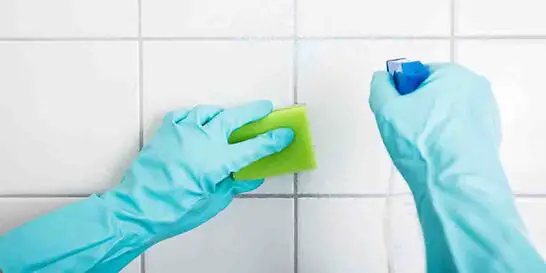You might have spotted saltwater stains on your bathroom’s tiles. Looking closely, It appears as a chalky white residue that builds up over time due to the presence of excessive minerals in hard water.
Saltwater stains are mostly seen when you have a borewell water supply at your house instead of city water. If you are near the seashore, it could be another reason for salts present in the water being deposited when the water on the tile dries out.
Not only tiles, but these saltwater stains can also form on your faucets, toilets, shower doors, showerheads, and other places which come in contact with hard water.
On the Authority of Kent HealthCare, it might get difficult to remove these stains because bathrooms hold standing water daily.
And That’s true also.
Do not worry! In this guide, I will share some of the working methods to get rid of saltwater stains from bathroom tiles.
But before that, let me tell you what causes saltwater stains on your tiles.
What Causes Salt Water Stains?
Hard water contains a higher concentration of minerals, including salts of calcium and magnesium. On daily usage, the water comes into contact with different places and settles down. This results in leaving a stain of chalky white residue that appears as a salt layer.
In some regions of the country, the winter season causes slippery driveways and parking lots. To prevent skidding on slippery ground, people use salt products that can cause damage by forming stains on different types of flooring, including tiles and wooden floors.
Precautions Before Cleaning Salt Stains from Bathroom Tiles
- Place Anti-Slip Bathroom Mats – Anti-Slip mats are great to reduce falls and slip. If you already have one, place it in the working area and try to walk around it to avoid faling.
- Wear Water Shoes – When cleaning, it is advisable to wear water shoes to get a grip on the water so that you can avoid falling. It also prevents your feet from getting exposed to microbes and chemicals that can cause infections.
- Wear Rubber Gloves – Also, consider using a household glove to protect yourself against bacteria and avoid contact with chemicals while cleaning.
How to Remove Salt Stains from Bathroom Tiles?

Method 1 – Using Oven Cleaner & Citric Acid
Ingredients to Keep Handy
- Oven Cleaner
- Citric Acid
- Bleach
- A Scrubber
- A Mop
Steps to Remove Salt Stains from Bathroom Tiles – Using Oven Cleaner & Citric Acid
- At times, gaps between the tiles can contain grease residue. It is important to wash all the grease stains away before removing saltwater stains. To remove grease residue, spray the oven cleaner between the gaps and scrub it hard. Besides, if you notice grout between the tiles, use a scrubber to remove it. After that, rinse the tiles with water. You will find all the grease and grout are now removed.
- As the floor is wet, it will seem the salt stains are gone. However, it’s still present there because you cannot see salt stains if a floor is wet. Now, wait for the floor to dry up.
- Once the floor is dry, use citric acid for treating salt stains. For that, we have to prepare a solution.
- Take 100 grams of citric acid and mix it with a mug of warm water (prepare the solution quantity based on your requirement). Next, apply the solution to salt stains and wait for at least 20 minutes.
- Now, scrub the stains and rinse the floor with water. When that is done, use a mop to clear out the water particles and wait for it to dry.
- Once the floor is dry, your final step is to wash the tiles with bleach, disinfecting the floor from germs.
That’s All!
Method 2 – Using Vinegar & Dish Soap
Ingredients to Keep Handy
- White Vinegar
- Dish Soap
- A Squeeze or Empty Bottle
- A Scrubber or Sponge
Steps to Remove Salt Stains from Bathroom Tiles – Using Vinegar & Dish Soap
- Vinegar and dish soap are great household products that can be used to remove saltwater stains from tiles. In fact, it can be easily found in your kitchen.
- Take an empty soap bottle or a squeeze bottle. Fill the bottle halfway with distilled white vinegar and another half with dish soap.
- Shake the bottle & get it to mix up well.
- Once the solution is mixed well, put that on your tiles where the white salt stains are visible.
- Finally, take a scrub brush or sponge, then start scrubbing all the way through the stains until it starts getting removed.
That’s All!
Method 3 – Using Borax & Vinegar
Ingredients to Keep Handy
- Borax Powder
- Vinegar
- A Scrubber or Sponge
Steps to Remove Salt Stains from Bathroom Tiles – Using Borax & Vinegar
- Take 1/4 cup of Borax powder and spread it on the tiles with salt stains.
- Now, put 1 cup of vinegar into the same place where you have spread the Borax powder initially.
- Allow this solution to settle down for 20 minutes.
- After that, take a scrubber and scrub the solution on entire stains.
- Once scrubbing is done, leave it for 5 minutes.
- Finally, rinse the tiles with water and you’re good to go.
Note – If the stains are strong, make a paste using Borax and water. Allow the paste to sit on the stains for an hour and scrub it out afterward.
FAQ: Remove Salt Water Stains from Bathroom Tiles
What makes vinegar a good cleaner for stains?
We generally see vinegar as a cooking product. Vinegar is a rather pungent yet versatile cleaning product. The acidic nature of vinegar is so strong that it makes itself a good disinfectant for cleaning tiles, toilets, showerheads, etc.u003cbru003eu003cbru003eWhite vinegar is usually used for cleaning purposes. It can remove stains, including mold, mildew, limescale, and salt stains. Also, more than that.
Does baking soda remove salt stains?
Baking soda is a type of salt that is made by mixing up two natural compounds i.e sodium carbonate and carbon dioxide. The mixture is so much versatile, it can be used for cooking, cleaning, medicine, personal hygiene, and more. Therefore, removing salt stains using baking soda is possible.
What is Borax Powder?
Borax is a common household and commercial cleaning product also called sodium tetraborate. This white mineral is being used for over a decade to remove stains, mold, and mildew. Apart from cleaning, it is a great pest controlling agent to get rid of ants, roaches, fleas, silverfish, and beetles.



